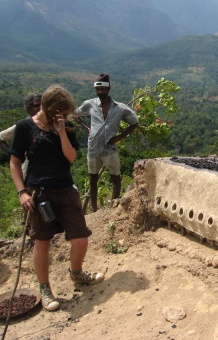
Dr. Juleff in Samanalawewa
Modern and ancient technology meet
Dr Gillian Juleff, Senior Lecturer in Archaeology, contributed to a new gallery which opened the past week featuring her research into the wind-powered iron and steel making furnaces of Samanalawewa, Sri Lanka – a first millennium AD industry based on a technology not seen elsewhere in the ancient world.
The National Gallery of Engineering Technological Heritage was opened in Colombo, Sri Lanka on the 26 June 2013. The ceremony was attended by the Minister of National Heritage, Dr Jagath Balasuriya, and the Minister of Power and Energy, Mrs Pavithra Devi Wanniarachchi.
The gallery was conceptualised and developed by the Institution of Engineers Sri Lanka (IESL), an organization which has a record of 106 years of service in collaboration with the Sri Lankan National Museum of Natural History.
Dr. Juleff comments, “It is an honour that our research and discoveries sit alongside national icons and World Heritage sites such as the ancient irrigation systems and the stupa of Jetawana. The new gallery marks an important moment when academic research enters the public domain and ownership becomes truly universal.”
The new gallery showcases five major engineering achievements of ancient Sri Lanka including Dr. Juleff’s research. Information on monsoon smelting technology has only come to light in the last two decades. The furnaces were first discovered in the 1990’s, and were tested and proven in a series of experimental trials that were reported on the cover of the scientific journal ‘Nature’ in 1996.
The imagination of the Sri Lankan public was captured in 2007 when a team of students from Exeter, funded by the Annual Fund, returned with Dr Juleff to carry out a further ‘Monsoon Steel’ experimental smelting campaign. The furnaces, of which there are many hundred archaeological examples, are located on the upper slopes of remote hills on the southern flanks of Sri Lanka’s Central Highlands. Every summer the area is subjected to constant, high-velocity monsoon winds that drive the unusual low, elongated furnaces, allowing them to reach temperatures high enough to smelt direct from iron ore to high-carbon steel. In the following year a further Exeter team funded by the Annual Fund designed and built a replica of the furnace in the popular Martin Wickremasinghe Folk Museum at Koggala on the southern coast of Sri Lanka.
The project to create the new gallery in the National Museum was developed by a committee of Engineers representing IESL, with Dr Premala Sivaprakaspillai, Sri Lanka’s first female engineer, leading the work to include an explanatory model and video of the wind-powered furnaces in the exhibition.
Dr Juleff is looking forward to returning to Samanalawewa in July this year to carry out further smelts in collaboration with IESL, the Central Electricty Board, engineers and industrialists in Sri Lanka. She adds “I was disappointed not to be able to attend the opening ceremony in person but I will be in Sri Lanka very soon to conduct another series of smelting experiments using the wind-powered furnaces. This time it will be for the group from the Institution of Engineers involved in the new gallery and moves beyond pure archaeological research. Let's see what happens when modern technology meets ancient technology!”
For further information on the National Gallery of Engineering Technological Heritage, see the Sri Lankan Department of National Museums website, or to find out more about Dr. Juleff’s Monsoon Steel research project, please see the Archaeology webpage.
Date: 8 July 2013
